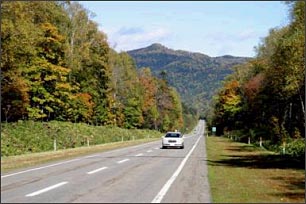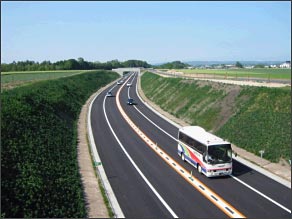Hokkaido Bureau
Road Development
Building Roads to Support Self-development of Hokkaido
With respect to Hokkaido roads, measures supporting the 21st century self-development of Hokkaido are proceeding based on the 6th term Hokkaido Comprehensive Development Plan. Taking into consideration changes in the economic-social situation since the plan was decided upon, steady advance can be seen in the basic network structure of Human, Physical and Information Distribution with the promotion of sightseeing exchange and formation of safe, livable, comfortable communities.
Placing priority on effective and efficient facilities, Hokkaido has promoted concrete measures such as a high-standard road artery networks and developing roads connected with major airports and seaports, barrier-free walking space, traffic safety measures, counter-measures to relieve city congestion, development of an information-communication infrastructure for reform of Hokkaido structure, maintaining and developing roadside scenery for creating comfortable moving space. Moreover, because of damage from frequent disasters, including typhoons, earthquakes, heavy snowfall and landslides, aiming at the formation of safe, comfortable communities, road disaster measures are advanced.
Placing priority on effective and efficient facilities, Hokkaido has promoted concrete measures such as a high-standard road artery networks and developing roads connected with major airports and seaports, barrier-free walking space, traffic safety measures, counter-measures to relieve city congestion, development of an information-communication infrastructure for reform of Hokkaido structure, maintaining and developing roadside scenery for creating comfortable moving space. Moreover, because of damage from frequent disasters, including typhoons, earthquakes, heavy snowfall and landslides, aiming at the formation of safe, comfortable communities, road disaster measures are advanced.

Roadside Scenery Characterizing Hokkaido (National Highway No. 273)
For the most effective, efficient as well as high transparency in the management of roads, road administration is result oriented. An outcome performance report on the degree of achievement in reaching set goals (project achievement index), called "Achievement Report / Performance Report," is made one year after the project is begun and the knowledge gained from evaluating former measures is reflected in the selection of important measures and budget for the following year.
[National Highway Projects]
High-standard arterial thoroughfares secure high-speed automobile traffic and provide exclusive automobile road access to connect a multi-polar, decentralized society. A project to develop a road network targeted at completing a 14,000km nation-wide road network uniting national expressways and national highways by the beginning of the 21st century is being promoted.
Hokkaido has a total of 1,825km of high-standard thoroughfares by combining 450km of 5 national highways and 1,375km of national expressways.
The goals of developing a high-standard thoroughfare network are relieving traffic congestion, mitigating the load on the environment, increasing logistic efficiency, etc., and at the same time connecting the central cities of 6 areas, Sapporo, Hakodate, Asahikawa, Obihiro, Kitami and Abashiri, Kushiro, for promoting exchange and cooperation between these core cities, since Hokkaido has a widely distributed type of social structure.
Hokkaido has a total of 1,825km of high-standard thoroughfares by combining 450km of 5 national highways and 1,375km of national expressways.
The goals of developing a high-standard thoroughfare network are relieving traffic congestion, mitigating the load on the environment, increasing logistic efficiency, etc., and at the same time connecting the central cities of 6 areas, Sapporo, Hakodate, Asahikawa, Obihiro, Kitami and Abashiri, Kushiro, for promoting exchange and cooperation between these core cities, since Hokkaido has a widely distributed type of social structure.

National Highway No. 39 (Bihoro Bypass) (scheduled to be open for public use in 2005)
Promoting the development of high-standard local roads and connecting them with national high-standard highway arteries to form a nationwide high-standard highway network is aimed at contributing to the development and revitalization of areas.
With respect to national highways, together with advancing road network development as a measure against disasters, securing safe traffic conditions and relieving city traffic congestion, building roads to connect main airports and harbors is being promoted.
Also, to provide secure, safe and comfortable traffic conditions, road surface repair and structural maintenance, providing road information, tree planting in city areas, etc., is fully promoted to enhance road environment.
With respect to national highways, together with advancing road network development as a measure against disasters, securing safe traffic conditions and relieving city traffic congestion, building roads to connect main airports and harbors is being promoted.
Also, to provide secure, safe and comfortable traffic conditions, road surface repair and structural maintenance, providing road information, tree planting in city areas, etc., is fully promoted to enhance road environment.
[Local Road Projects]
Since prefecture roads, as thoroughfares for the area, are important for increasing logistics (physical distribution) efficiency, broadening the living environment, vitalization of center city activity, supporting the promotion of tourism, etc., projects are promoted to solve problems in traffic interruption areas, measures to deal with winter traffic and traffic safety, etc.
With respect to village and city streets, emphasis is placed on promoting maintenance of commuter roads and bus routes connecting to cooperative facilities which are basic to daily life.
With respect to village and city streets, emphasis is placed on promoting maintenance of commuter roads and bus routes connecting to cooperative facilities which are basic to daily life.
[Large-scale Bicycle Roads]
To ensure bicycle traffic safety, a wide-area bicycle lane project is being promoted with the purpose of contributing to the development of healthy minds and bodies.
[Road Disaster Measures Projects]
The Hokkaido Bureau promotes the development of a reliable road network to cope with disasters, such as typhoons, earthquakes, heavy snowfall and landslides to make the area safe and strong in response to disaster. Special emphasis is placed on checking the slopes of bridges that were designed based on the old standard and promoting anti-seismic reinforcement, placing priority on coping with catastrophic disasters.
To respond promptly and efficiently as soon as road damage appears, a cooperative volcanic disaster prevention WAN network using optical cable to share disaster information has been formed for communication between concerned organs such as road administration.
To respond promptly and efficiently as soon as road damage appears, a cooperative volcanic disaster prevention WAN network using optical cable to share disaster information has been formed for communication between concerned organs such as road administration.
[Snow and Freezing Projects]
The Hokkaido Bureau initiates snow removal projects to ensure safe and smooth automobile traffic and improve pedestrian space in winter. Wide area freeze damage prevention projects are also promoted for protection against avalanches and snow drifts, improvement of roadbeds by installing snow dumping areas, facilities such as snow sheds, snow fences, and snow break forest groves as snow disaster measures, striving to ensure a safe, pleasant road traffic network in the winter season.
Snow melting maintenance projects introducing new technology are also developed to produce a peaceful winter environment with measures to prevent slippery road surface, a serious concern in cities. Also, positive advancement of cooperative measures with volunteer groups in the area are promoted to take care of the details of winter road projects.
Snow melting maintenance projects introducing new technology are also developed to produce a peaceful winter environment with measures to prevent slippery road surface, a serious concern in cities. Also, positive advancement of cooperative measures with volunteer groups in the area are promoted to take care of the details of winter road projects.
[Traffic Safety Projects]
The number of traffic deaths in Hokkaido since 1992 on, is one of the worst in the nation, making the prevention of traffic accidents a big topic.
For this reason, along with introducing a priority clear system, measures are promoted to raise the level of effective, efficient traffic safety on major arterial thoroughfares, such as improving street crossings to reduce traffic accidents in areas where accidents are frequent and where major accidents occur. Especially in areas where many head-on collision accidents occur, new technology is introduced, such as barrier strips on the division line to maintain a central belt. Moreover, we advance maintenance of safe passing space, such as installing bicycle and pedestrian lanes centering on school zones.
In cooperation with local self-governing bodies, development of "Michi-no-eki (road stations)" equipped with a parking lot, toilets, facilities for relaxation, all types of information, local promotion, etc. are being promoted.
For this reason, along with introducing a priority clear system, measures are promoted to raise the level of effective, efficient traffic safety on major arterial thoroughfares, such as improving street crossings to reduce traffic accidents in areas where accidents are frequent and where major accidents occur. Especially in areas where many head-on collision accidents occur, new technology is introduced, such as barrier strips on the division line to maintain a central belt. Moreover, we advance maintenance of safe passing space, such as installing bicycle and pedestrian lanes centering on school zones.
In cooperation with local self-governing bodies, development of "Michi-no-eki (road stations)" equipped with a parking lot, toilets, facilities for relaxation, all types of information, local promotion, etc. are being promoted.
[Street Projects]
Among street projects, based on city planning, the development of residential unit major roads as an artery for the formation of the city framework and good city environment is promoted.
Regarding land area readjustment projects, aiming at basic reorganization of the central areas of cities or local vitalization to create a good habitation environment in a new city area, unified development of life infrastructure facilities, such as roads and parks and housing sites in an established city area is promoted.
Regarding land area readjustment projects, aiming at basic reorganization of the central areas of cities or local vitalization to create a good habitation environment in a new city area, unified development of life infrastructure facilities, such as roads and parks and housing sites in an established city area is promoted.
[Road development contributing to vitalization of central city areas]
To promote the development of public facilities in central city areas, the Ministry of Land, Infrastructure and Transport Hokkaido Bureau, with the cooperation of other ministries, is promoting several measures, including the "Core City Area Comprehensive Development Project" and, since the 1995 fiscal year, the "Building a Neighborly Town" project.
A core city area comprehensive maintenance project is a project which forms the base of new city activity in the central area of a core city, by carrying out priority and synthetic development of urban infrastructure facilities, such as roads, parks, sewage, scenery formation, high-tech information advancement, focused on developing new city activities.
Moreover, the "Building a Neighborly Town" project is a project for promoting vitalization of an area in the central city area by undertaking a unified development of along-the-route facilities such as stations, public offices, shopping centers, roads, parks, sewage, etc., plan, aimed at creating friendly areas which take advantage of the scenery of the area, and a charming life space to revitalize the area.
A core city area comprehensive maintenance project is a project which forms the base of new city activity in the central area of a core city, by carrying out priority and synthetic development of urban infrastructure facilities, such as roads, parks, sewage, scenery formation, high-tech information advancement, focused on developing new city activities.
Moreover, the "Building a Neighborly Town" project is a project for promoting vitalization of an area in the central city area by undertaking a unified development of along-the-route facilities such as stations, public offices, shopping centers, roads, parks, sewage, etc., plan, aimed at creating friendly areas which take advantage of the scenery of the area, and a charming life space to revitalize the area.